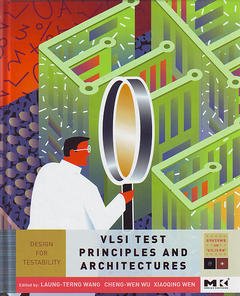Description
VLSI Test Principles and Architectures
Design for Testability
Authors: Wang Laung-Terng, Wu Cheng-Wen, Wen Xiaoqing
Language: English
Subjects for VLSI Test Principles and Architectures:
81.69 €
Subject to availability at the publisher.
Add to cart
Publication date: 08-2006
808 p. · 19x23.3 cm · Hardback
808 p. · 19x23.3 cm · Hardback
Description
/li>Contents
/li>Readership
/li>Biography
/li>Comment
/li>
This book is a comprehensive guide to new DFT methods that will show the readers how to design a testable and quality product, drive down test cost, improve product quality and yield, and speed up time-to-market and time-to-volume.
Chapter 1 – Introduction
Chapter 2 – Design for Testability
Chapter 3 – Logic and Fault Simulation
Chapter 4 – Test Generation
Chapter 5 – Logic Built-In Self-Test
Chapter 6 – Test Compression
Chapter 7 – Logic Diagnosis
Chapter 8 – Memory Testing and Built-In Self-Test
Chapter 9 – Memory Diagnosis and Built-In Self-Repair
Chapter 10 – Boundary Scan and Core-Based Testing
Chapter 11 – Analog and Mixed-Signal Testing
Chapter 12 – Test Technology Trends in the Nanometer Age
Chapter 2 – Design for Testability
Chapter 3 – Logic and Fault Simulation
Chapter 4 – Test Generation
Chapter 5 – Logic Built-In Self-Test
Chapter 6 – Test Compression
Chapter 7 – Logic Diagnosis
Chapter 8 – Memory Testing and Built-In Self-Test
Chapter 9 – Memory Diagnosis and Built-In Self-Repair
Chapter 10 – Boundary Scan and Core-Based Testing
Chapter 11 – Analog and Mixed-Signal Testing
Chapter 12 – Test Technology Trends in the Nanometer Age
PRIMARY: Practitioners/Researchers in VLSI Design and Testing; Design or Test Engineers, as well as research institutes.
SECONDARY: Undergraduate and graduate-level courses in Electronic Testing, Digital Systems Testing, Digital Logic Test & Simulation, and VLSI Design.
SECONDARY: Undergraduate and graduate-level courses in Electronic Testing, Digital Systems Testing, Digital Logic Test & Simulation, and VLSI Design.
Laung-Terng Wang, Ph.D., is founder, chairman, and chief executive officer of SynTest Technologies, CA. He received his EE Ph.D. degree from Stanford University. A Fellow of the IEEE, he holds 18 U.S. Patents and 12 European Patents, and has co-authored/co-edited two internationally used DFT textbooks- VLSI Test Principles and Architectures (2006) and System-on-Chip Test Architectures (2007).
- Most up-to-date coverage of design for testability.
- Coverage of industry practices commonly found in commercial DFT tools but not discussed in other books.
- Numerous, practical examples in each chapter illustrating basic VLSI test principles and DFT architectures.
© 2024 LAVOISIER S.A.S.




